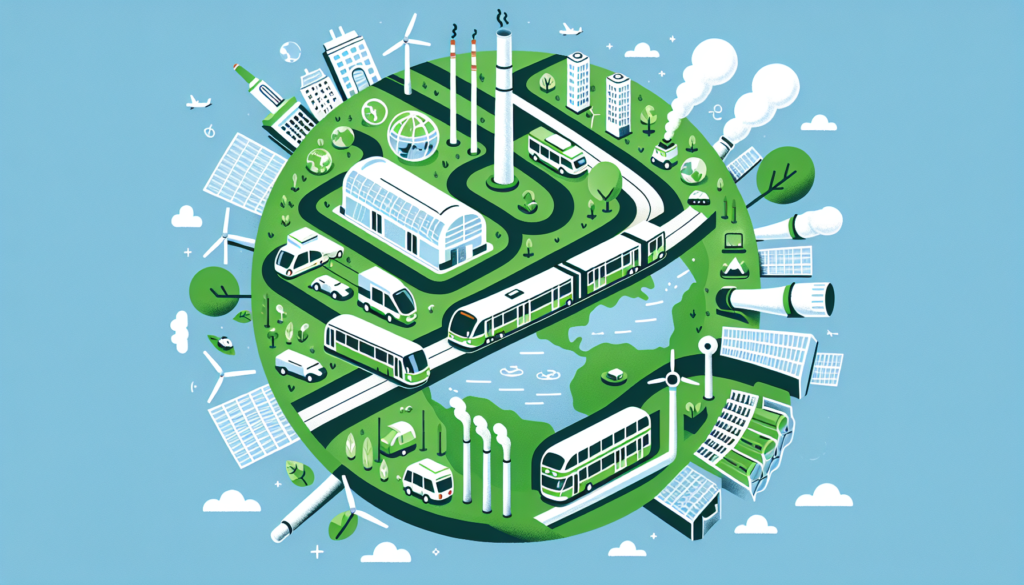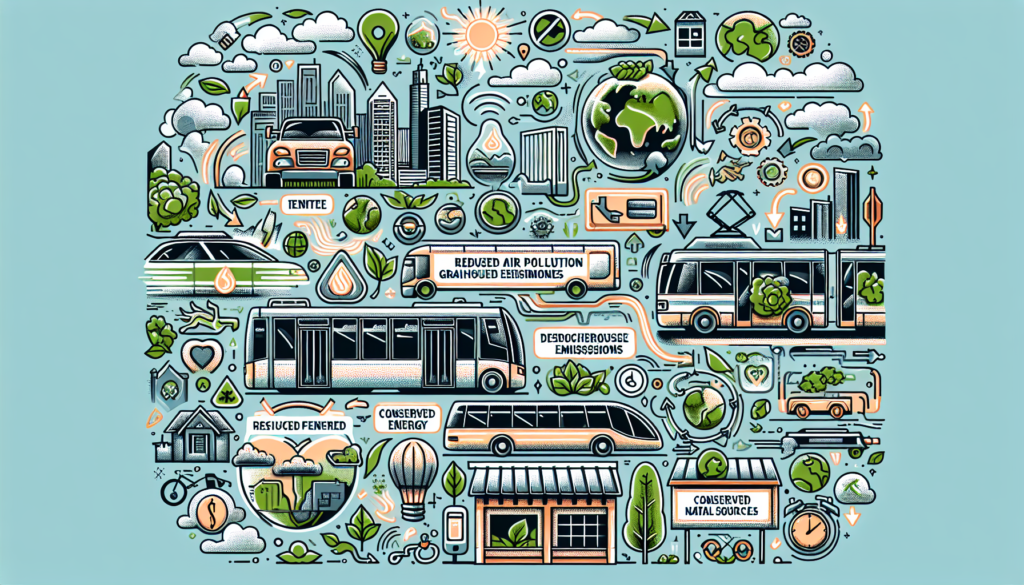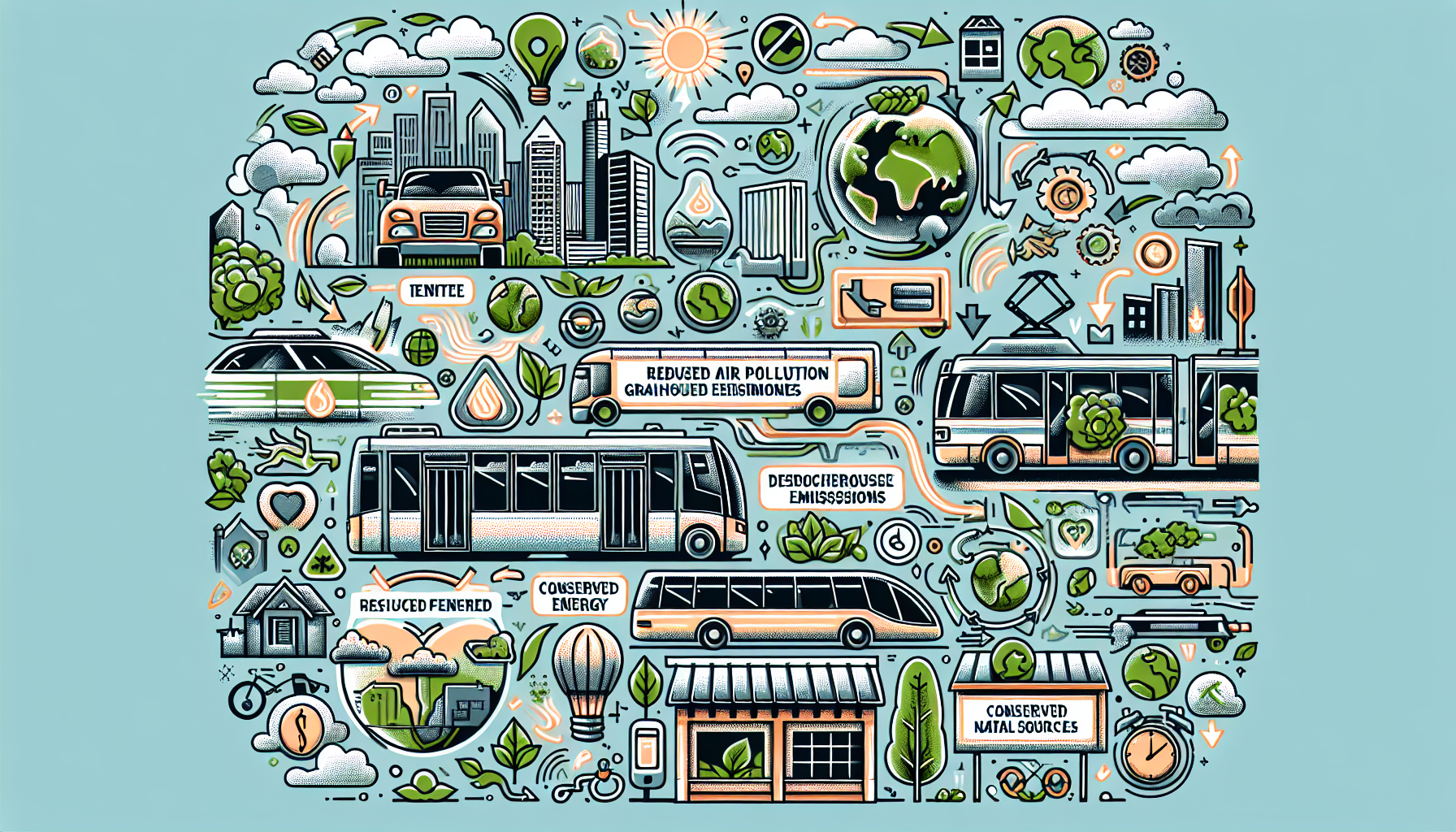Are you looking for an easy and effective way to do your part for the environment? Look no further than public transportation! Not only is it a convenient and affordable way to get around, but it also has numerous benefits for the environment. By opting to take the bus or train instead of driving your own car, you can help reduce air pollution and greenhouse gas emissions, conserve energy, and minimize your carbon footprint. In this article, we will explore the various ways in which public transportation positively impacts the environment and why it’s a great choice for eco-conscious individuals like yourself. Get ready to discover the amazing benefits of public transportation for the environment and how it can make a real difference in tackling climate change.
Reduced Air Pollution
Less Traffic Congestion
Public transportation helps reduce traffic congestion by taking cars off the road. When more people choose to use buses, trains, or trams, the number of vehicles on the streets decreases. This leads to smoother traffic flow, faster travel times, and less time wasted in congested areas. By opting for public transportation, you can contribute to a more efficient and less congested road network, making everyone’s commute easier and more enjoyable.
Lower Emissions from Vehicles
One of the most significant advantages of public transportation is the reduction in emissions from vehicles. Public transit options typically use cleaner and more fuel-efficient technologies, resulting in fewer greenhouse gas emissions. Buses, for example, carry multiple passengers at once, reducing the number of individual cars emitting pollutants. By switching to public transportation, you help combat air pollution and minimize your carbon footprint.
Improved Air Quality
By reducing the number of cars on the road and lowering vehicle emissions, public transportation significantly improves air quality. The pollutants produced by cars, such as carbon monoxide, nitrogen oxide, and particulate matter, contribute to respiratory diseases and other health issues. With public transportation, fewer emissions are released into the atmosphere, leading to cleaner air and healthier living environments for all.
Decreased Greenhouse Gas Emissions
Reduced CO2 Emissions
One of the major contributors to climate change is the release of carbon dioxide (CO2) into the atmosphere. Personal vehicles are a significant source of CO2 emissions, but public transportation offers a greener alternative. Studies have shown that using public transit can reduce a person’s carbon footprint by up to 37% compared to using a private car. By opting for public transportation, you can play a crucial role in decreasing CO2 emissions and combatting global warming.
Less Contribution to Global Warming
Public transportation plays a crucial role in mitigating global warming. As mentioned earlier, it helps reduce CO2 emissions, which are a primary greenhouse gas responsible for trapping heat in the Earth’s atmosphere. By utilizing public transportation options, you are actively participating in the fight against climate change and working towards a more sustainable future for all.

Conservation of Energy
Less Fuel Consumption
Public transportation is more fuel-efficient than individual cars. Buses and trains are designed to carry a larger number of passengers, effectively achieving more passenger-miles per gallon of fuel. When more people choose public transportation, the overall fuel consumption decreases, resulting in less dependence on fossil fuels and a more sustainable energy future.
Lower Dependency on Fossil Fuels
Reducing our reliance on fossil fuels is crucial for both environmental and economic reasons. By using public transportation, we can decrease the demand for gasoline and diesel, which are derived from fossil fuels. This helps conserve finite natural resources, reduce pollution associated with extracting and processing these fuels, and move towards greener and more renewable energy sources.
Preservation of Natural Resources
Reduced Land Use
The land required for building and maintaining transportation infrastructure is substantial. Public transportation systems, such as railways and bus lanes, require significantly less land compared to road networks for individual cars. By utilizing public transportation, we can reduce the need for sprawling road networks, protect natural habitats, and preserve valuable land for other purposes like agriculture or wildlife conservation.
Protection of Wildlife Habitats
Building roads and expanding highways often disrupt and fragment wildlife habitats, leading to negative impacts on biodiversity. Public transportation can help minimize this disruption by reducing the need for new roads and promoting compact and efficient transportation systems. By opting for public transit, we contribute to the preservation of wildlife habitats, allowing ecosystems to thrive and maintaining the delicate balance of our natural environment.

Reduced Noise Pollution
Quieter Streets
The constant noise generated by cars, especially during peak traffic hours, can be a major source of stress and annoyance. Public transportation reduces the number of cars on the road, resulting in quieter and more peaceful streets. By choosing public transit, you can enjoy a quieter commute, reduce noise pollution in your neighborhood, and create a more calming atmosphere for everyone.
Less Noise-related Health Issues
Exposure to high levels of noise pollution can have detrimental effects on our health, leading to issues such as hearing loss, increased stress levels, and sleep disturbances. Public transportation reduces noise pollution by minimizing the number of individual cars. Choosing to use buses, trains, or trams can lead to improved overall well-being and better quality of life due to reduced exposure to harmful noise levels.
Improved Health and Safety
Decreased Traffic Accidents
Traffic accidents are a significant concern for both individuals and communities. Public transportation can help alleviate this issue by reducing the number of cars on the road. With fewer vehicles, the risk of accidents decreases, making public transit a safer mode of transportation. By using public transportation, you can contribute to creating safer roads and promoting a culture of responsible and mindful commuting.
Increased Physical Activity
Daily physical activity is essential for maintaining a healthy lifestyle. Public transportation often involves walking to and from stations or stops, providing individuals with the opportunity to incorporate physical activity into their daily routines. By incorporating walking or cycling as part of your public transportation journey, you can improve your overall fitness levels and contribute to a healthier lifestyle.
Better Air Quality and Health
As mentioned earlier, public transportation helps improve air quality by decreasing vehicle emissions. Cleaner air translates to better respiratory health for individuals using public transit and those living in the surrounding communities. By reducing our contribution to air pollution and choosing public transportation, we are actively investing in better health outcomes for ourselves and future generations.
Social Equity
Accessible Transportation for All
Public transportation plays a vital role in ensuring equitable access to essential services and opportunities. It provides a means of transportation for individuals who may not have access to private vehicles, such as low-income communities, people with disabilities, and the elderly. By investing in public transportation and supporting its expansion, we can ensure that everyone has equal access to education, employment, healthcare, and other necessities.
Reduced Transportation Costs for Individuals
Owning and maintaining a private car can be costly, especially when considering expenses like fuel, parking, maintenance, and insurance. Public transportation offers a cost-effective alternative, allowing individuals to save money on transportation expenses. By utilizing public transit, you can reduce your transportation costs, allocate your resources more effectively, and potentially improve your overall financial well-being.
Economic Benefits
Reduced Infrastructure Costs
The construction and maintenance of roads, highways, and parking facilities require substantial financial investments. By shifting towards public transportation, we can reduce the need for extensive road networks and parking infrastructure. This leads to significant cost savings in terms of construction, maintenance, and ongoing repairs, allowing for the allocation of resources to other critical areas of development.
Savings on Vehicle Ownership
The costs associated with owning a private vehicle, such as purchasing, maintaining, and insuring it, can add up quickly. Public transportation offers an alternative to vehicle ownership by providing a reliable and affordable means of transportation. By opting for public transit, individuals can save money on buying and maintaining a car, allowing for greater financial flexibility and potentially improving their overall quality of life.
Positive Influence on Real Estate
Increased Property Values
Public transportation networks have been shown to positively impact property values. Areas with good access to public transit tend to attract higher levels of investment and development, leading to increased property values. Living near convenient public transportation options can enhance the desirability of a neighborhood, making it an attractive choice for both homeowners and investors.
Attractive Neighborhoods with Good Transportation Options
Public transportation systems contribute to the creation of attractive and vibrant neighborhoods. Access to efficient and convenient transportation options is a key factor in urban planning and development. By investing in public transit and fostering well-designed transportation networks, we can create neighborhoods that prioritize accessibility, walkability, and community cohesion.
Decreased Road Maintenance
Reduced Wear and Tear on Roads
Road maintenance and repairs are a continuous and costly process. The more vehicles on the road, the faster deterioration occurs, requiring frequent maintenance and repairs. Public transportation helps by reducing the number of private vehicles, resulting in less wear and tear on roads. By utilizing public transit, we can contribute to preserving road infrastructure, reducing the need for constant repairs, and saving taxpayer dollars.
Lower Infrastructure Costs
The construction and maintenance of road infrastructure involve significant financial investments. By prioritizing public transportation and decreasing the reliance on private cars, we can reduce the need for extensive road networks and associated infrastructure. This leads to cost savings in terms of construction, maintenance, and ongoing repairs, allowing for the allocation of resources to other vital areas of infrastructure development.
Public transportation offers numerous benefits for the environment, economy, and communities as a whole. By reducing air pollution, greenhouse gas emissions, noise pollution, and road maintenance costs, it helps create cleaner, healthier, and more sustainable cities. The preservation of natural resources, improved accessibility, and economic advantages further highlight the importance of investing in public transportation. So the next time you plan a trip, consider hopping on a bus, train, or tram and join the movement towards a greener and more efficient future. Your contribution matters, and together we can make a difference.

